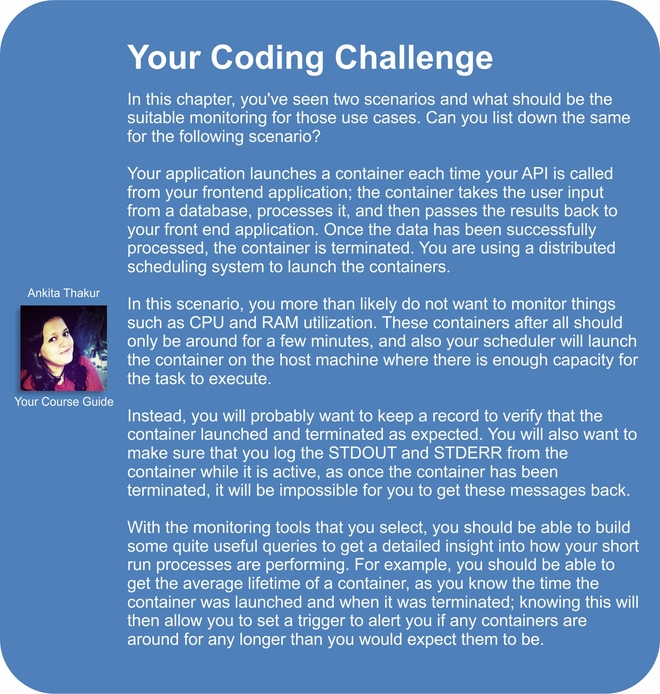 Keeping up
by Scott Gallagher, Allan Espinosa, Russ McKendrick, Santosh Kumar Konduri, Vaibhav
Docker: Creating Structured Containers
Keeping up
by Scott Gallagher, Allan Espinosa, Russ McKendrick, Santosh Kumar Konduri, Vaibhav
Docker: Creating Structured Containers
- Docker
- Table of Contents
- Docker
- Meet Your Course Guide
- 1. Course Module 1: Learning Docker
- 1. Getting Started with Docker
- An introduction to Docker
- Docker on Linux
- Differentiating between containerization and virtualization
- Docker networking/linking
- Installing Docker
- Downloading the first Docker image
- Running the first Docker container
- Running a Docker container on Amazon Web Services
- Troubleshooting
- 2. Up and Running
- Docker terminologies
- Docker commands
- The daemon command
- The version command
- The info command
- The run command
- The search command
- The pull command
- The start command
- The stop command
- The restart command
- The rm command
- The ps command
- The logs command
- The inspect command
- The top command
- The attach command
- The kill command
- The cp command
- The port command
- Running your own project
- Dockerfile
- 3. Container Image Storage
- 4. Working with Docker containers and images
- 5. Publishing Images
- 6. Running Your Private Docker Infrastructure
- 7. Running Services in a Container
- 8. Sharing Data with Containers
- 9. Docker Machine
- 10. Docker Compose
- 11. Docker Swarm
- 12. Testing with Docker
- 13. Debugging Containers
- 1. Getting Started with Docker
- 2. Course Module 2: Networking Docker
- 1. Docker Networking Primer
- 2. Docker Networking Internals
- 3. Building Your First Docker Network
- 4. Networking in a Docker Cluster
- 5. Next Generation Networking Stack for Docker – libnetwork
- 3. Course Module 3: Monitoring Docker
- 1. Introduction to Docker Monitoring
- 2. Using the Built-in Tools
- 3. Advanced Container Resource Analysis
- 4. A Traditional Approach to Monitoring Containers
- 5. Querying with Sysdig
- 6. Exploring Third Party Options
- 7. Collecting Application Logs from within the Container
- 8. What Are the Next Steps?
- 4. Course Module 4: Securing Docker
- 1. Securing Docker Hosts
- 2. Securing Docker Components
- 3. Securing and Hardening Linux Kernels
- 4. Docker Bench for Security
- Docker security – best practices
- Docker – best practices
- CIS guide
- The Docker Bench Security application
- Running the tool
- Understanding the output
- Understanding the output – host configuration
- Understanding the output – the Docker daemon configuration
- Understanding the output – the Docker daemon configuration files
- Understanding the output – container images and build files
- Understanding the output – container runtime
- Understanding the output – Docker security operations
- 5. Monitoring and Reporting Docker Security Incidents
- 6. Using Docker's Built-in Security Features
- 7. Securing Docker with Third-Party Tools
- 8. Keeping up Security
- 5. Course Module 5: Mastering Docker
- 1. Docker in Production
- 2. Shipyard
- 3. Panamax
- 4. Tutum
- 5. Advanced Docker
- A. Reflect and Test Yourself! Answers
- Module 1: Learning Docker
- Chapter 1: Getting Started with Docker
- Chapter 6: Running Your Private Docker Infrastructure
- Chapter 7: Running Services In a Container
- Chapter 8: Sharing Data with Containers
- Chapter 9: Docker Machine
- Chapter 10: Orchestrating Docker
- Chapter 11: Docker Swarm
- Chapter 12: Testing with Docker
- Chapter 13: Debugging Containers
- Module 2: Networking Docker
- Module 3: Monitoring Docker
- Module 4: Securing Docker
- Chapter 2: Securing Docker Components
- Chapter 3: Securing and Hardening Linux Kernels
- Chapter 4, Docker Bench for Security
- Chapter 5, Monitoring and Reporting Docker Security Incidents
- Chapter 6, Using Docker's Built-in Security Features
- Chapter 7, Securing Docker with Third-party Tools
- Chapter 8, Keeping up Security
- Module 5: Mastering Docker
- Module 1: Learning Docker
- B. Bibliography
- Index
While Docker has been built on top of well-established technologies such as Linux Containers (LXC), these have traditionally been difficult to configure and manage, especially for non-system administrators.
Docker removes almost all the barriers to entry, allowing everyone with a small amount of command-line experience to launch and manage their own container-based applications.
This has forced a lot of the supporting tools to also lower their barrier to entry. Software that once required careful planning to deploy, such as some of the monitoring tools we covered in this module, can now be deployed and configured in minutes rather than hours.
Docker is also a very fast-moving technology; while it has been considered production-ready for a while, new features are being added and existing features are improved with regular updates.
So far, in 2015, there have been 11 releases of Docker Engine; of these, only six have been minor updates that fix bugs, and the rest have all been major updates. Details of each release can be found in the project's Changelog, which can be found at https://github.com/docker/docker/blob/master/CHANGELOG.md.
Because of the pace of development of Docker, it is import that you also update any monitoring tools you deploy. This is not only to keep up with new features, but also to ensure that you don't loose any functionality due to changes in the way in which Docker works.
This attitude of updating monitoring clients/tools can be a bit of a change for some administrators who maybe in the past would have configured a monitoring agent on a server and then not thought about it again.



-
No Comment